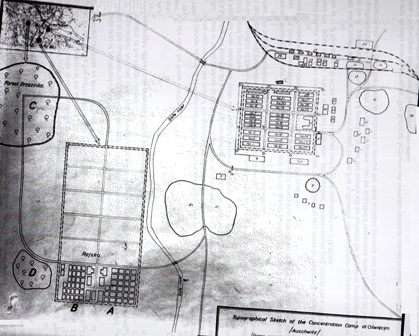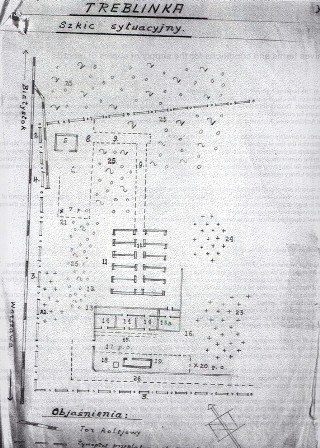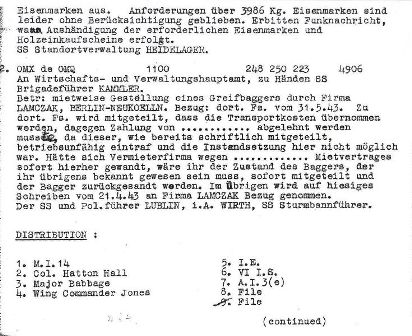Holocaust Education & Archive Research Team |
Revolt & Resistance
Acts of Resistance
Jewish Resistance
Groups Jewish Resistors Allied Reports Anti-Nazi Resistance Nazi collaborators
| |||
Allied Reports
Auschwitz and Treblinka
The Jewish Agency For Palestine 77 Great Russell Street London WC1 18th August 1944
Dear Mr. Millard,
As arranged on the telephone this afternoon I enclose herewith plans and descriptions of the two death camps – at Auschwitz (Oswiecim) and Treblinka (Trzebinia), which I have just received from the Polish Ministry of the Interior.
Yours sincerely,
J. Linton
Enclosures : Auschwitz Drawing and Treblinka Report 1944
Treblinka Treblinka A is for Poles who committed offences against the occupation army by not delivering the imposed quota of agricultural products or were caught smuggling. The discipline is very severe – the prisoners are being shot under the smallest pretext. The fame of this camp is established as well as that of Auschwitz / Oswiecim. In March 1942, the Germans have started the building of a new camp- Treblinka B, near Treblinka A. This camp was designated as a concentration camp for Polish Jews and for Jews from other European countries. On the building were employed Poles from the neighbouring camp and Jews, caught in the small towns in the vicinity. The camp was completed at the end of April, when also was built the centre point of the camp – the death house. The new camp – Treblinka B is situated on sandy hills among brush-wood. The area of the camp is comparatively small. It is about 5,000 hect. The camp is surrounded by a green fence interwoven with barbed wire entanglements. Part of the fence runs through a young forest in the north. At the four corners of the camp, observation points were placed for the Lagerschutz (camp guard). The Lagerschutz consists mostly of Ukrainians armed with machine guns. At the observation points strong searchlights have been placed to light the entire place at night. Observation posts are also set in the middle of the camp and on the hills in the woodlands. The western border of Treblinka B is formed by the rail embankment along which runs a side-track that connects the camp with the main railroad line. The side-line was constructed in recent months, in order that the trains of transports might be delivered directly to the slaughter-house. The northern border of the camp is formed by the forest; east and south the border cuts through sandy hills. In the area of the camp, bushes form a long stretch parallel to the railroad tracks starting in the north. A railroad – crossing is adjacent to the side-track; from that barrier there is an entrance to a square which holds two to three thousand persons. The square is fenced in with barbed wire. On the square, not far from the northern corner of the square there is a guard house with a military post on 24 hour duty. South of the square, outside of the fence, there is a cloth-sorting place and further south there is an execution place of the camp commandant, and the graves of the victims murdered by him. The arrival square is connected with the rest of the area by an entrance in the north-eastern corner of the fence. From there a path runs through the woods for about 200 metres eastwards and then turns at right angles to the south and runs along the forest, parallel to the western limit of the arrival square. This road stops at a large building of an unusual shape: it is an unfinished one-storey brick construction, about 40 meters long and 15 metres wide. When we received the information concerning Treblinka B in the first half of September, this building was about to be finished. The Germans began the construction of that building after the action started, probably in the middle of August, with the help of Jewish artisans picked out from among the Jews brought to Treblinka for slaughter. It is significant that the bricks for the construction had been brought from as far as Warsaw, in trucks attached to each transport. The bricks were loaded in the Warsaw “Umschlagplatz” by Jewish workers. According to the report of an eyewitness, the interior of the building is as follows: A corridor 3 metres wide runs through the middle, there are five chambers on each side, the height of each chamber is about 2 metres; the area about 35 square metres. The execution chambers are without windows, but they have doors opening on the corridor and a type of valve on the outside walls. Next to these valves there are large scoops, they remind one of large vessels. In the walls pipes were installed from which water-steam is supposed to pour into the chambers. This was to have been death-house No.2. A path skirts the building and runs along its western wall finally ending at the next building near death-house No 1. This building is at right angles to the death-house No.2. It is a brick construction much smaller than the other. It consists of only three chambers and a steam-room. Along the northern wall of this house runs a corridor from which there are doors to the chambers. The outside walls of the chambers have valves (until recently doors which had been changed into valves for utility reasons). Also here a scoop in the shape of a shallow vessel is placed at the height of the valves.
The steam-room is adjacent to the building: inside the steam-room there is a large vat which produces the steam. The hot steam comes into the chambers through pipes installed there, each having the prescribed number of vents. While this machinery of death is in action, the doors and valves are hermetically closed. The floor in the chambers has a terra-cotta inlay which becomes very slippery when water is poured over it. There is a well next to the steam-room, the only well in the whole area of Treblinka B. Not far from the death-house, south of the barbed wire and wooden fences, there is the grave- digger’s camp. The grave-diggers live in barracks next to which are the kitchen buildings. On both sides of the camp there are two guard –houses. The remaining area of Treblinka B is destined for the murdered victims. A part of that area is already a large cemetery. At first Poles employed in the camps dug the graves; later the slaughter was intensified and the need for more ditches grew, special digging machines / bulldozers were brought, which ran day and night at grave digging. A diesel motor supplies the energy and its rattle is a characteristic sound at Treblinka B.
Sources:
The Chris Webb Archive Holocaust Historical Society Archives UK National Archives KEW
Copyright Victor Smart H.E.A.R.T 2011
|


